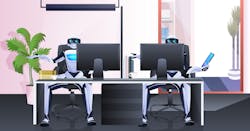You Can’t Run a Business on Technology Alone
COMMENTARY
We are in the midst of a critical struggle, and it seems like some of us have not learned from past mistakes. The Great Resignation. Global worker shortages. Supply chain disruptions. And still, it seems as if we want to re-live one of our greatest errors by forgetting human workers when we deploy technology on shop floors around the world.
Robotics, artificial intelligence and automation are gifts, but if we just slap them upon our organizations, we do very little to reap their rewards. Instead, we may end up vilifying the blessings they may be able to deliver. So, let’s be clear: In today’s world, fully automated workflows are more the stuff for science fiction. These technologies come with a set of critical restrictions and limits. What we need instead is augmentation to support operators on the shop floor. We need them to trust in the technology we provide, we need to listen to them, blend in with them and appreciate the value they deliver every day. Or else, we will end up paying an expensive price.
Try Teaching a Robot
Merely replacing workers with robots is currently not an option for one simple, yet striking reason: It’s not possible. Try teaching a robot to grab a single t-shirt from a shelf instead of the whole stack. Or, attempt to have it come up with a spontaneous fix for a fairly simple error that could bring everything in an automated environment to a standstill. Automation isn’t easy to implement. It requires major investments and comes with extensive complexity. But what’s more is the fact that this approach, in combination with all the alienating talk about automation, generates the feeling that manufacturing has no future for human labor. This may very well annihilate the motivation for shop floor operators to get a job in production.
This scenario—one in which workers are apprehensive to enter manufacturing—would certainly not help address the current worker shortage. During my participation at The Augmented Workforce Experience WEF panel, I learned that in the U.S. alone some 800,000 workers are in demand. And we are looking at 3 million open manufacturing jobs in five years’ time. As a rule of thumb, you can assume that every dollar spent in manufacturing almost triples its value for the U.S. economy. This provides a sense of the value missed if we are not investing in the manufacturing workforce.
Let’s face it: The human worker is probably the most underrated factor on the shop floor and in global supply chains. Humans not only have the ability to resolve issues quickly; they can also collaborate instantly and have an intrinsic—at times even playful—motivation to learn. All of this is instrumental to make operations work because we cannot run businesses only on technology. So, rather than pursuing an aimless quest, we should focus on how workers can better interact bidirectionally with the machines that surround them. We need guided workflows that will comprehensively bridge the gaps we are currently facing.
Harness the Shopfloor Worker to Drive Digitalization
So, how do we go about that? We need to engage with our workers, listen to them, hear them, bring them in the picture. We need to monitor their workflows with them, look at short intervals, eliminate paper, and connect them to a digital environment. It is crucial to work with them to make their lives easier, eliminate repetitive jobs with the help of technology, and—lastly—supply the technology they need. In other words: We can and should harness the shopfloor worker to drive digitalization across our businesses.
Robotics and automation need to complement the human workforce. Therefore, we need “cobots” that are working alongside human workers to relieve them of the strenuous and iterative jobs they can do so much better than their human counterparts. This certainly also calls for intuitive tools that bridge the gap at the interface between the two worlds, such as wearable devices that can augment the worker while allowing them to collect the data points without providing a Big Brother-like surveillance system.
Let’s stay away from buzzwords. Let’s shut down the closed gardens that have us rush into technology that does not help and will instill an undesirable fear factor. We need to build ecosystems that welcome human labor and encourage them to share their experience while sticking to the script.
Above all, this requires cultural leadership, which includes human values in all processes. This strategy has all the necessary ingredients to make the jobs easier, upscale wages, and raise productivity. In short: Leveraging technology serves business and makes jobs that we need to fill right now more appealing to workers ready to take them on.
Andreas Koenig is CEO of ProGlove, a provider of wearable barcode scanners.
About the Author
Andreas Koenig
Andreas Koenig is CEO of ProGlove, a provider of wearable barcode scanners.
